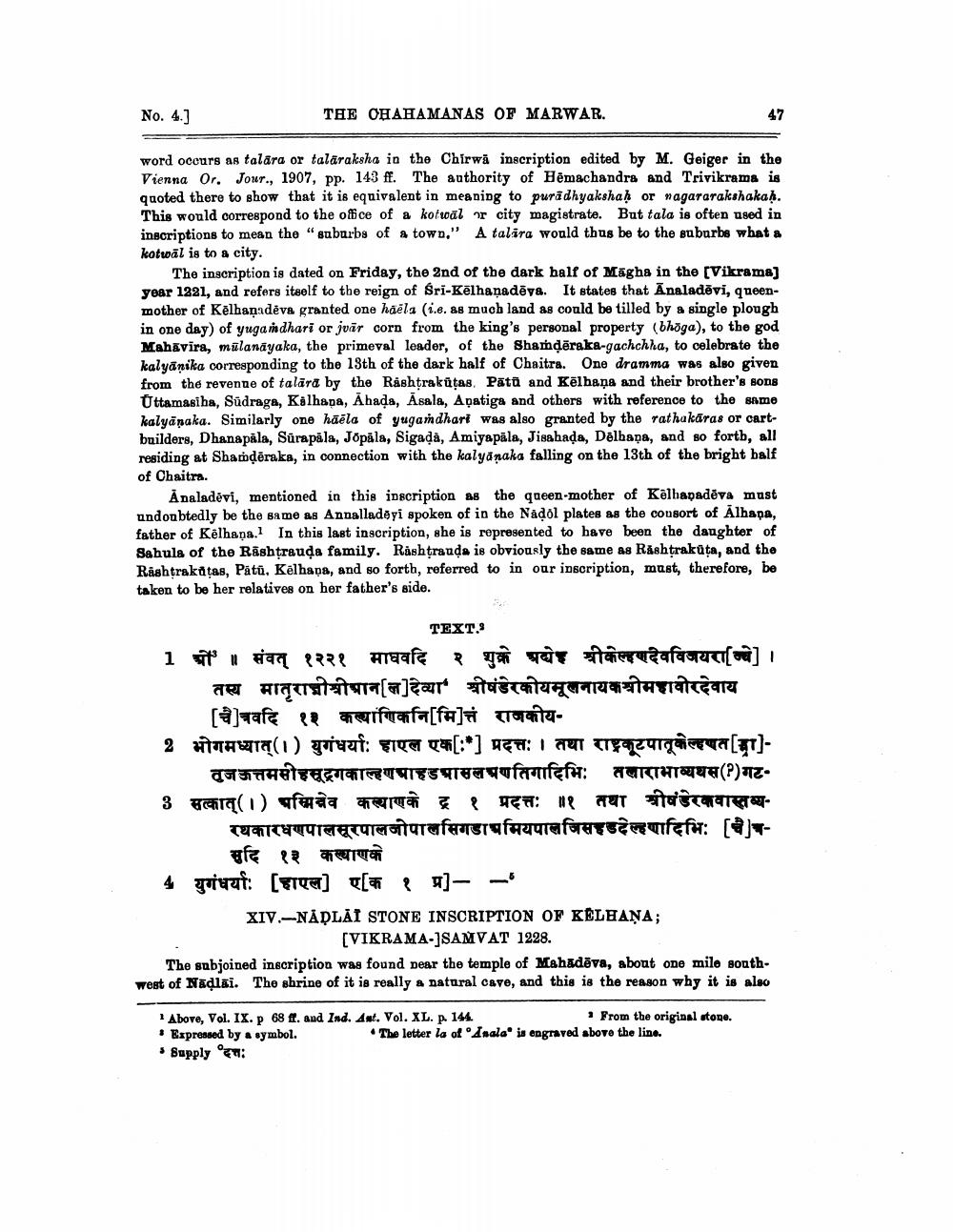________________
No. 4.]
THE OHAHAMANAS OF MARWAR.
word occurs as talara or taläraksha in the Chirwa inscription edited by M. Geiger in the Vienna Or. Jour., 1907, pp. 143 ff. The authority of Hēmachandra and Trivikrama is quoted there to show that it is equivalent in meaning to puridhyakshaḥ or nagararakshakaḥ. This would correspond to the office of a kotwal or city magistrate. But tala is often used in inscriptions to mean the "suburbs of a town." A talira would thus be to the suburbs what a kotwal is to a city.
The inscription is dated on Friday, the 2nd of the dark half of Maghs in the [Vikrama] year 1221, and refers itself to the reign of Sri-Kelhanadēya. It states that Analadēvi, queenmother of Kelhaņadēva granted one häēla (i.e. as much land as could be tilled by a single plough in one day) of yugandhari or juār corn from the king's personal property (bhöga), to the god Mahavira, mūlanayaka, the primeval leader, of the Shamdēraka-gachchha, to celebrate the kalyānika corresponding to the 13th of the dark half of Chaitra. One dramma was also given from the revenge of talāra by the Rashtrakūtas. Pātã and Kēlhana and their brother's son Úttamasiha, Sūdraga, Kolhapa, Ahada, Āsala, Apatiga and others with reference to the same kalyānaka. Similarly one haëla of yugamdhari was also granted by the rathakaras or cartbuilders, Dhanapala, Surapala, Jopala, Sigada, Amiyapāla, Jisahada, Delbana, and so forth, all residing at Shandėraka, in connection with the kalyanaka falling on the 13th of the bright balf of Chaitra.
Analadevi, mentioned in this inscription as the queen-mother of Këlhapadēva must undonbtedly be the same as Annalladayi spoken of in the Nádol plates as the consort of Alhapa, father of Kēlhapa. In this last inscription, she is represented to have been the daughter of Sahula of the Rashtrauda family. Rashtranda is obviously the same as Råshtrakūta, and the Rashtrakåtas, Patü, Kelhana, and so forth, referred to in our inscription, must, therefore, be taken to be her relatives on her father's side.
TEXT. 1 ओं' ॥ संवत् १२२१ माघवदि २ शुक्र प्रवेश श्रीकल्हणदेवविजयरा[च्चे] ।
तस्य मातृरात्रीश्रीमान[ल] देव्या' श्रीषंडेरकीयमूलनायकत्रीमहावीरदेवाय
[@]yafe i rafa[ff]* toiter 2 Axta(1) gruaf: Fica C#[:*] 4@#: 1 me qeurgaavat [T)
तुजऊत्तमसीहसूद्रगकाल्हणपाहडपासलपणतिगादिभिः सखाराभाव्यवस(१)गट3 सत्कात्(1) पस्मिन्नेव कल्याणके टू १ प्रदत्त: १ तथा श्रीषंडेरकवास्तव्य
रथकारधणपालसूरपालजीपालसिगडापमियपालसिहदेल्हणादिभिः [चेच
सुदि १३ कल्याणके 4 quuf: [erre] [ ]- XIV.-NÅDLĀI STONE INSCRIPTION OF KELHAŅA;
[VIKRAMA-]SAVAT 1228. The subjoined inscription was found dear the temple of Mahadēva, about one mile southWest of Nādai. The shrine of it is really a natural cave, and this is the reason why it is also
1 Above, Vol. IX.p 68 ft. and Ind. . Vol. XL. p 144.
From the original stone. • Expressed by a symbol.
The letter la of Analais engraved above the line. • Supply :




